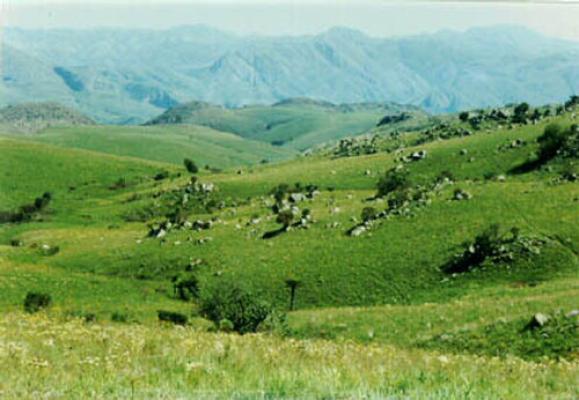

Malolotja Nature Reserve is one of the most impressive mountain parks in Southern Africa.
The spectacular scenery and the variety of fauna and flora makes it a prime highveld conservation area. It is the last unspoilt mountain wilderness left in Swaziland.
The reserve extends over an area of 18 000 hectares in north-west Swaziland, making it the largest proclaimed protected area in the Kingdom.
The range in altitude from the top of Ngwenya Mountain, Swaziland's second highest mountain (1829m), to the deep Nkomati River Valley (640m) accounts both for the mild temperate climate and great variety of habitats; from short grassland, to thick riverine scrub, bushveld and moist Afro-montane forest.
The Malolotja Falls along Malolotja River are the highest waterfalls in Swaziland.
Flora
One of Malolotja's greatest attractions is undoubtedly its flora. Throughout the year the variety and profusion of wild flowers provides a magnificent spectacle. Several species of plants, restricted for the most part to the Barberton greenstone belt of southern Africa, are also found growing in Malolotja.
Some of the more important threatened species are the cycads, of which two species occur within the reserve, namely the Barberton and Kaapsehoop cycads (Encephalartos paucidentatus and E. laevifolius)
Birding
More than 280 species of birds have been recorded from Malolotja and the reserve is particularly important for breeding groups of endangered species, such as the blue swallow, blue crane, bald ibis and Stanley's bustard.
Only two breeding colonies of the bald ibis exist in Swaziland, and one of these is found inside the reserve.
The bog and vlei systems are home to striped flufftails, blackrumped buttonquails and blue cranes; the streams and riverbanks to giant, malachite and halfcollared kingfishers and the African finfoot; the high protea woodland to sunbirds and Gurney's sugarbirds; the short grassland to blue swallows, anteating chats, blackwinged plovers and Stanley's bustard; and the rock outcrops to sentinel rock thrushes, buffstreaked chats and ground woodpeckers.
Mammals
Sixty-three species of mammals have been recorded from the reserve, including a number of rare and Regionally Threatened species. Nine species, mostly small mammals but also including Aardwolf (Proteles cristatus), Black Wildebeest (Connochaetes gnou), and Red Hartebeest (Alcelaphus buselaphus) occur nowhere else in Swaziland.
Malolotja has a great variety of small mammals (from Rock hyraxes to shrews) numbering thirty species, including three species of grass-climbing mice (Dendromus spp.) and seven species of shrews (Family Soricidae).
Malolotja has important populations of other rare species such as Serval (Felis serval), White-tailed Mongoose (Ichneumia albicauda), Antbear (Orycteropus afer), Grey Rhebok (Pelea capreolus), Common Reedbuck (Redunca arundinum), Oribi (Ourebia ourebi), Klipspringer (Oreotragus oreotragus) and Red Duiker (Cephalophus natalensis).
The two African Elephants (Loxodonta africana) frequent the Nkomati valley and the middle and lower Malolotja valley, and occasional sightings of Hippopotamus (Hippopotamus amphibius) are made in the Nkomati River.
Environmental Education Centre
The Environmental Education Centre is situated next to the Malolotja River, which makes it easy and convenient for birds (both terrestrial and aquatic species) enthusiasts. Next to the centre is a natural forest serving as a habitat for both floral and faunal species such as bush pigs and small antelope.
The Centre is able to accommodate groups of students and provide environmental education activities for them.
Malolotja provides protected wetland, woodland, highveld grassland and mistbelt forest habitats for a wide variety of plant and animal life and must surely stand out as one of the most important protected areas in southern Africa.